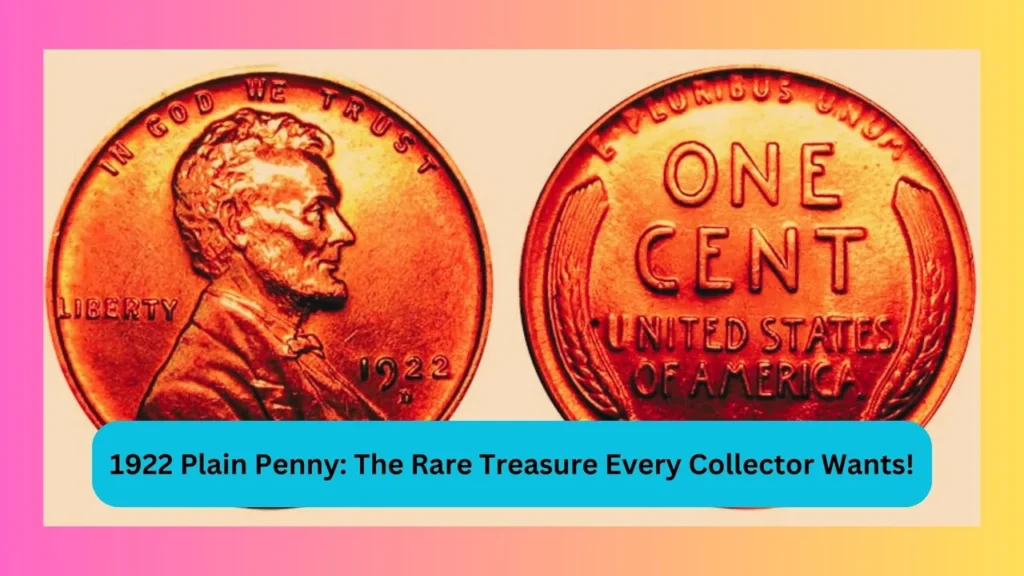Introduction
Have you ever heard of the 1922 Plain Penny? If not, buckle up because this little coin packs a big punch in the numismatic world! It’s one of the most sought-after Lincoln cents, and if you’re lucky enough to own one, you could be sitting on a small fortune.
In this article, we’re diving deep into the history, rarity, value, and collecting tips for the legendary 1922 Plain Penny. Whether you’re a seasoned collector or a curious newbie, you’ll find everything you need to know right here!

What is the 1922 Plain Penny?
A Quick Overview
The 1922 Plain Penny is a rare variation of the Lincoln Wheat Cent, minted in Denver. Unlike most 1922 pennies, this particular coin lacks a visible mintmark (‘D’ for Denver), which makes it extremely rare and valuable.
Why Is It Called “Plain”?
Typically, pennies from 1922 have a ‘D’ mintmark because the Denver Mint was the only facility producing cents that year. However, due to worn-out dies and excessive polishing, some coins were struck without a visible mintmark—creating the famous “Plain” variety.
The Story Behind the 1922 Plain Penny
The Minting Mishap
In 1922, the U.S. Mint had no plans to strike cents in Philadelphia or San Francisco, leaving Denver as the sole producer. But with heavy use, the dies at the Denver Mint started to wear out. To compensate, workers over-polished some dies, accidentally removing the ‘D’ mintmark entirely.
The Accidental Rarity
Since most 1922 pennies carry the ‘D’ mintmark, the Plain Penny became an oddity. Numismatists quickly recognized its uniqueness, and it has since become a prized possession among collectors.
How to Identify a Genuine 1922 Plain Penny
Not all 1922 pennies without a ‘D’ are the real deal. Here’s how to identify a genuine one:
1. No Visible Mintmark
- A true 1922 Plain Penny has no ‘D’ at all. Some weakly struck pennies might appear to lack a mintmark but aren’t the true Plain variety.
2. Strong Reverse Design
- The reverse (tails side) should have clear and well-defined details. If the design looks weak or worn, it might not be the rare variety.
3. Die Pair 2 Confirmation
- Experts classify the 1922 Plain Penny as “Die Pair 2.” This means:
- The obverse (heads side) has a weakly struck “LIBERTY.”
- The “IN GOD WE TRUST” is somewhat mushy.
- The reverse details remain relatively sharp.
Why is the 1922 Plain Penny So Valuable?
Extreme Rarity
Only a small number of these pennies exist today, making them highly desirable. The fewer coins available, the higher their value!
Collector Demand
Coin collectors love rare mistakes! The 1922 Plain Penny is a prime example of a valuable error coin, boosting its price tag.
Historical Significance
The story behind its creation adds to the mystique and desirability. Owning one is like holding a piece of minting history.
How Much is a 1922 Plain Penny Worth?
Factors That Affect Value
Several factors determine the value of this rare penny:
- Condition (Grade) – The better the condition, the higher the price.
- Authenticity – Genuine Die Pair 2 coins are worth significantly more.
- Market Demand – Prices fluctuate based on collector interest.
Estimated Value by Condition
| Condition | Estimated Value |
|---|---|
| Good (G4) | $500 – $900 |
| Very Fine (VF20) | $2,000 – $5,000 |
| Extremely Fine (EF40) | $6,000 – $9,000 |
| Uncirculated (MS60+) | $10,000 – $50,000+ |
Some pristine specimens have even sold for over $100,000!
Where to Buy or Sell a 1922 Plain Penny
Online Marketplaces
- eBay – Be cautious; check for authentication.
- Heritage Auctions – Trusted for high-end coin sales.
- GreatCollections – A solid choice for serious collectors.
Local Coin Dealers
Visit reputable coin shops to get a professional evaluation and potentially sell your coin.
Coin Shows & Auctions
These events are great places to find serious buyers and sellers of rare pennies.
How to Authenticate Your 1922 Plain Penny
Step 1: Visual Inspection
Look for the missing ‘D’ and strong reverse design.
Step 2: Use a Magnifying Glass
Examine the coin under magnification to verify its characteristics.
Step 3: Get a Professional Opinion
Have it graded by a reputable company like PCGS (Professional Coin Grading Service) or NGC (Numismatic Guaranty Corporation).
Tips for Collecting Rare Pennies
1. Educate Yourself
Know what to look for before making a purchase.
2. Buy from Reputable Sellers
Avoid scams by purchasing from verified dealers or auction houses.
3. Store Your Coins Properly
Use airtight holders to prevent damage and preserve value.
4. Get Your Coins Graded
A certified grade increases the coin’s credibility and resale value.
5. Stay Updated on Market Trends
Prices fluctuate, so keep an eye on the market to buy or sell at the right time.
Conclusion
The 1922 Plain Penny isn’t just another old coin—it’s a numismatic treasure with a fascinating backstory. Whether you’re a collector, investor, or just someone who loves rare finds, this penny is worth knowing about.
If you ever come across one, hold onto it—it might just be your lucky penny!
FAQs
1. How many 1922 Plain Pennies exist today?
There’s no exact count, but experts estimate only a few thousand genuine coins remain in circulation.
2. Can I find a 1922 Plain Penny in pocket change?
It’s highly unlikely, but not impossible. Most are already in collections or dealer inventories.
3. What’s the difference between a weak ‘D’ and a Plain Penny?
A weak ‘D’ still has a faint mintmark, while a Plain Penny has no mintmark at all.
4. Is the 1922 Plain Penny the rarest Lincoln cent?
It’s one of the rarest, but the 1909-S VDB Lincoln Cent is often considered rarer.
5. Should I clean my 1922 Plain Penny?
No! Cleaning can damage the coin’s surface and drastically reduce its value.
If you found this guide helpful, share it with fellow collectors and keep an eye out—you never know what treasures you might find!